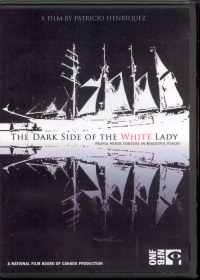| ________________
CM . . .
. Volume XIV Number 21. . . .June 13, 2008 
 |
The Dark Side of the White Lady.
Patricia Henriquez (Director). Colette Loumede (Producer).
Montreal, PQ: National Film Board of Canada, 2006.
102 min., VHS or DVD, $99.95.
Order Number: 153E 9907 138.
Grades 9 and up / Ages 14 and up.
Review by Reece Steinberg.
*** /4
|
| |
|

excerpt:
People torture to defend economic interests. More than to defend the nation, for instance, torture is used for defend economic interests... to safeguard American investments abroad. That's why we were tortured. (Esmeralda torture survivor)
People of this country understand the importance of economic freedom. (George W. Bush, speaking of Chile)
A Chilean marina filled with yachts, cruise ships, and a large crowd of cheering families opens this film. The multi-generational crowd is poised to welcome the arrival of the Esmeralda, the Chilean navy's training vessel which is nationally renowned for its beauty. The scene cuts to another crowd which demands justice and truth from the organization who used the White Lady to intern, torture and kill Chileans after the 1973 coup d'état. The conflict between the two groups is fierce: is the ship a prized national ambassador or the navy's former "torture centre"?
The Dark Side of the White Lady is largely composed of interviews with people who survived torture on the ship, family members of those who did not survive, and witnesses. It balances this perspective with interviews and clips of speeches from current and former navy officials, though the film is intended to be subjective and supportive of the torture survivors. The former prisoners of the ship and their family members introduce the horrors the captives faced, including abductions at gunpoint, physical and mental abuse and death. Survivors speak frankly, and in detail of the brutal torture they endured, as well as about their lives today. One self-proclaimed "stubborn old woman" photographs and develops pictures of the ship to come to terms with the horror she continues to feel.
This film deserves praise for presenting the seemingly unfiltered views and words of victims of military abuse. These people speak passionately and powerfully about the events that happened over 30 years ago, as well as about their continued struggle to force the Navy to be accountable for its actions. In the first half of the film, navy officials adamantly deny that torture occurred on the Esmeralda and belittle the former prisoners' experiences. Dark and sinister footage of the ship and crashing waves of the sea accompany the interviews, echoing the emotions of the speakers. This adds some visual interest to the film which is otherwise mostly the interviewees in front of an often stark background. This highlights one issue of the film. While the end of the film begins to explore the context of the imprisonment, the demands of the protestors and other relevant details, the first two-thirds is almost all interviews which require a prior knowledge of events in Chilean history. Viewers without a basic understanding of the coup and its implications, which may include many younger viewers, will inevitably lose much of the meaning behind the interviews and consequently lose interest in the film.
The last third of the film investigates the various requests of the victims and their families, as well as the Chilean navy's tepid responses. There is a little more historical context to the coup, as well as information on the political climate of Chile today. The film touches on the disinterest of the press, the political use of torture and the injustice of an arm of the government performing an investigation on its own crimes. These issues are not explored thoroughly as that is beyond the scope of the film, but they may provoke thought in viewers and could be topics of discussions in group settings.
The Dark Side of the White Lady is a solid film which incorporates personal histories, aspects of Chile's political environment, and many complex questions which could apply to various countries and time-periods. It would be a useful addition to studies on Chile's political history, the history or politics of torture, and other topics in which the viewers had an adequate interest in or knowledge of the subject matter. It has descriptions of torture, including rape, which may be upsetting to some people.
Recommended.
Reece Steinberg is a Canadian librarian and writer, currently in Berlin, Germany.

To comment
on this title or this review, send mail to cm@umanitoba.ca.
Copyright © the Manitoba Library Association. Reproduction for personal
use is permitted only if this copyright notice is maintained. Any
other reproduction is prohibited without permission.
NEXT REVIEW |
TABLE OF CONTENTS FOR THIS ISSUE
- June 13, 2008.
AUTHORS |
TITLES |
MEDIA REVIEWS |
PROFILES |
BACK ISSUES |
SEARCH |
CMARCHIVE |
HOME |
